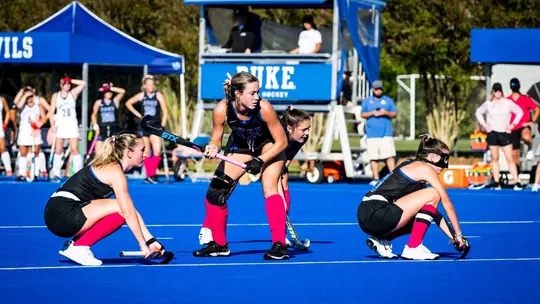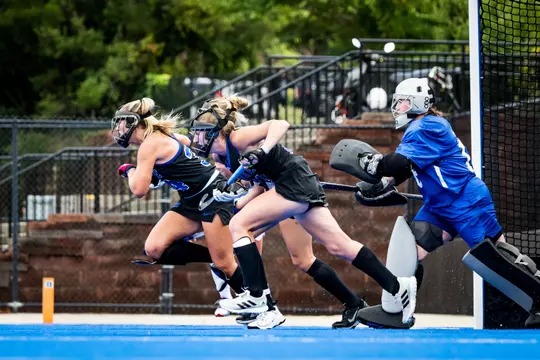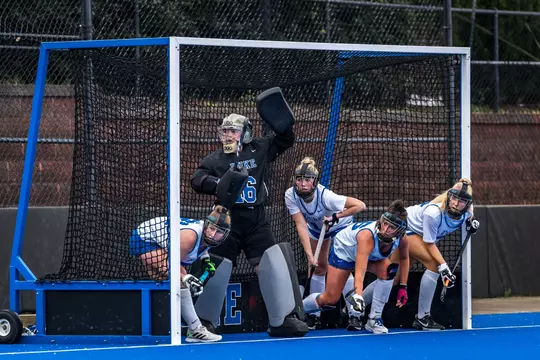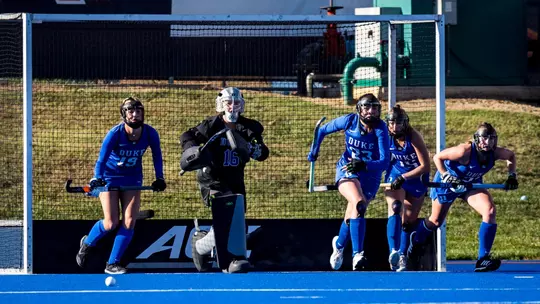
The Art of the Penalty Corner
Let’s talk a little bit about the field hockey penalty corner. It is fast, intense, precise and chaotic all at the same time. The play can be heart-stopping or gut-wrenching depending on your point of view as eight offensive players take on four defenders and a goalie.
On offense you have the insert, stick stoppers, the hitters/draggers, and the L1 and the R1 and R2s as tippers. It takes precision from each position to either score or defend, and the feeling when you see it cross the line is either exhilarating or defeating.
“I would say just keeping a calm head [is key to success on corners],” said Duke stick-stopper Mary Harkins. “They are a huge opportunity to change the pace of the game, change the score of the game so I think settling down and coming together and encouraging everyone to do their role and do it to the best of their ability. There is something about a corner goal because there are so many people involved. It took more than one person. It took the whole team.”
Defensively, you have the flyer, the right trail, the left trail, the post and the goalkeeper – a group of five courageous players versus eight attacking players inside the circle. The four defenders – oftentimes Megan Maransky, Kira Curland, Josephine Veen, Paige Bitting and sometimes Harkins, step behind the cage and put on protectives masks and gloves as goalie Piper Hampsch surveys the opponent before turning around to direct the defense.

Mainly you need to talk to your defense. You split time. You start to look at the top of the circle and see what’s there, but ultimately you’re there for your own defenders so talk to them and then step into the cage.”Piper Hampsch on turning her back on the opponent prior to the penalty corner.
“Mainly you need to talk to your defense,” said Hampsch about turning her back on the opponent prior to the penalty corner. “You split time. You start to look at the top of the circle and see what’s there, but ultimately you’re there for your own defenders so talk to them and then step into the cage.”
Duke field hockey has excelled in penalty corner situations on both ends of the field this season. The Blue Devils are averaging 5.55 penalty corners per game and allowing just 4.25 per outing this season. They have scored 24 goals on their 111 penalty and given up 10 goals on 85 defensive corners for impressive 22 and 88-percent success rates, respectively.
Duke’s success has forced opponents to adjust throughout the season so sometimes the hours of scouting are thrown out of the window – especially defensively. But the Blue Devils have figured out how to problem solve on the fly.
“We do a ton of scouting to see what their skills are, who can hit, who can sweep, who can drag, who we expect to be on top of the battery and what their preferred corners are, so you have an idea of what you expect them to do,” Hampsch said. “Obviously that can change, and as we’ve gotten further into the season, we’ve realized teams are starting to add new corners specifically for our defense, which is a huge compliment to what we can do, but also a bit tricky in terms of problem solving.”
The Blue Devils did not find this success overnight – they scored on just 7.2 percent of their opportunities last year and gave up a wealth of goals as well. They put in the work, dedicating hours of repetition on both sides this past spring.
“In the spring we did so many corners,” said Duke’s inserter Hannah Miller. “We just did repetition after repetition and that’s how you get comfortable with each other and the speed of execution for the insert to the trap to the hit.”

A penalty corner is awarded when a player commits a foul within the striking circle or a player commits a deliberate foul within 23 meters of the goal. A corner also stops the game clock and is played out to completion should the quarter expire during the play.
On offense, the inserter lines up on a mark 10 yards from the goal post with at least one foot outside the field of play. At the top of the circle, oftentimes for the Blue Devils you will see two stick-stoppers – most often Harkins and Charlie van Oirschot and two others prepared for the sweep or drag. Three others – the L1 and the R1 and R2, are on either side of the circle as options to shoot or for a tip.
On the other side of the ball there is Curland as Duke’s flyer – the individual who sprints directly to the hitter to attempt to block a shot or get a piece of the ball to make life easier for the goalie and the rest of her defense. Then you have the left trail – Maransky – and the right trail – Bitting or Harkins sometimes – who are responsible for the offensive players running in to the tip the ball and then Veen as the post player who is an extension of the goalkeeper.
Defensive penalty corners – DPCs – do take a certain amount of willingness to sacrifice your body. A field hockey ball, made of hard plastic or composite materials, is very hard so the willingness to put your body on the line must be there. It is also why the four players put on masks and gloves before lining up on the goal line.
“Courage probably,” a laughing Hampsch said about what’s necessary for the post player to be successful. “It’s an extension of the goalkeeper so it’s a goalkeeper without pads and I admire that. More than that, you’re defending part of the cage on the initial shot and then being responsible for a lot of rebounds. It’s a super high-level position so having someone who is strong with her stick and smart is important. For someone like Veen who can get physical and box someone out is always a perk.”
Once the whistle is blown for an offensive corner, Miller pushes the ball in to Harkins and Duke executes its designed corner, which are taped to their sticks, and hopefully finds the back of the cage directly or off a rebound. On the flip side, Hampsch uses her hours of scouting with assistant coach Jess Jecko to read what the opponent will do.
For Miller, who has inserted 176 corners over the past two seasons and 241 in her career, remaining calm and relying on muscle memory is crucial to providing the perfect pass to the top of the circle.
“I am just staying super focused because as soon as my focus waivers that’s when it goes awry,” said Miller. “Just getting down there – I don’t even want to know how many inserts I’ve done over the past four years – so I just rely on all the times I’ve practiced it. It’s second nature at this point so I don’t really think about it.”
Harkins also focuses on maintaining her calm presence and receives Miller’s pass with the poise and preciseness necessary for the next step to be successful. This season, it’s been sophomore Macy Szukics as the primary sweeper. And her delivery has been spectacular whether she’s shooting to score or aiming for a tip in front of the goal.
“If I’m aiming for a tip, I definitely want it stay on the ground because I’m not trying to make it hard on my teammates, I’m trying to make it as easy as possible for them,” said Szukics about her execution. “When I am trying to shoot to score, I do try to keep it on the ground sometimes, but if I can get a little bit of a hop on it, if the goalie is going down and I can get it over their stick that would be ideal.”
Most recently, van Oirschot has been the player to redirect Szukics’ balls. The senior captain scored a stellar tip-in goal against North Carolina in the regular-season finale and then had one almost identical in the ACC Tournament quarterfinal win over Wake Forest – proof that no matter how much you scout, sometimes the Blue Devils are just too good.
“I think she’s good at getting in front of people and Macy’s delivery is spectacular,” Harkins said about van Oirschot’s ability to redirect the ball. “She also has a good nose to reach for it and her angle is always good.”
Charlie giving us deja vu today ?? #DukeTrue pic.twitter.com/UrHR6VzAni
— Duke Field Hockey (@DukeFH) November 1, 2023
It’s not just van Oirschot or Szukics who can score. The list is long for the Blue Devils. McVeigh can strike it from the top of the circle with force and run in for the tip.
“It’s so exciting,” said McVeigh about scoring on a tip. “It looks nice. It’s one of the best and most exciting goals to score.”
Logan Clouser is dangerous from the L1 spot, Josephine Palde is a threat on the right side and recently had the winning goal against the Demon Deacons, knocking in the rebound from an Issy Carey shot. Barb Civitella will step up as the inserter if Miller is taking a breather and won’t miss a beat. The options are numerous for head coach Pam Bustin, and she’s relished watching all the offseason work pay dividends.
The other end is equally as satisfying to see for the Blue Devils, and they are only getting better. Duke gave up four goals off penalty corners in the first five games and have allowed just six in the past 15. The DPC unit against Louisville in the ACC Championship semifinal was especially spectacular.
Curland, a late addition to the unit as a flyer, was sensational in getting her stick down and blocking shots. Hampsch came up with big saves as well against the Cardinals, who earned four straight penalty corners in the first five minutes of the game.
Whistle after whistle, the Blue Devils, with Hampsch’s encouragement, remained unfazed. They lined up and each player performed her assigned duties to keep the Cardinals from taking the early lead in a game Duke ended up winning, 1-0.
“I’ve convinced myself and my teammates that repeat corners actually favor defenses,” Hampsch said. “You’ve just stopped three corners, why not do a fourth versus an attack mindset that is probably ‘Why can’t we score? This is our fourth time trying.’ I don’t know whether or not it’s true, I just keep hyping people up that ‘You’ve done it for that long and that you can do one more and maybe this is the one that starts our counterattack. Maybe this is the one that seals the game for us.’.”
As the flyer, it looks like Curland is the one most in the line of fire, but she claims otherwise. She’s eyeing the inserter to see the moment she pushes the ball in to get her jump off the line. Curland, who is fast and gets her stick down well, has frustrated opposing corner units recently.
“I think it’s better the closer you get the less you get hit so I’m trying to get really close and get any touch on it, so it makes it easier for Piper to save the ball,” said Curland. “I think definitely getting low and being in the line. I’m not going to move out of the way. If you’re close even if the ball hits you, it usually doesn’t hurt that bad. Just always stay in front.”
Our defense has posted 8?? shutouts so far this season (the most since 2003)! Looking for another one tonight ?? #DukeTrue pic.twitter.com/MdoNbqjdw7
— Duke Field Hockey (@DukeFH) November 3, 2023
For Hampsch, she must make a quick decision whether to stay on her feet to knock the ball way or to go down to take up as much space as possible in front of the cage. Meanwhile, her two trailers are focused on making sure the inserter and the opposing L1, R1 and R2 can’t get the tip, which are very difficult for goalies to save.
The action looks frantic as the four defenders race off the goal line and attackers rush into the circle as the ball arrives to the stick-stopper. However, every touch and step matters on both sides of the ball. The position of your body or stick can either as an attacker or defender mean the difference between giving up or scoring a goal. It’s truly a game of inches.
The Blue Devils will put their penalty corner units to the test again this weekend as Duke begins its quest for its first NCAA field hockey title. The action gets underway Friday at noon with the Blue Devils hosting American and you can be sure Duke’s APC and DPCs are ready to shine.

